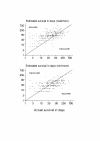Accuracy of prognosis estimates by four palliative care teams: a prospective cohort study
- PMID: 11876829
- PMCID: PMC88964
- DOI: 10.1186/1472-684x-1-1
Accuracy of prognosis estimates by four palliative care teams: a prospective cohort study
Abstract
BACKGROUND: Prognosis estimates are used to access services, but are often inaccurate. This study aimed to determine the accuracy of giving a prognosis range. METHODS AND MEASUREMENTS: A prospective cohort study in four multi-professional palliative care teams in England collected data on 275 consecutive cancer referrals who died. Prognosis estimates (minimum - maximum) at referral, patient characteristics, were recorded by staff, and later compared with actual survival. RESULTS: Minimum survival estimates ranged <1 to 364 days, maximum 7 - 686 days. Mean patient survival was 71 days (range 1 - 734). In 42% the estimate was accurate, in 36% it was over optimistic and in 22% over pessimistic. When the minimum estimate was less than 14 days accuracy increased to 70%. Accuracy was related, in multivariate analysis, to palliative care team and (of borderline significance) patient age. CONCLUSIONS: Offering a prognosis range has higher levels of accuracy (about double) than traditional estimates, but is still very often inaccurate, except very close to death. Where possible clinicians should discuss scenarios with patients, rather than giving a prognosis range.
Figures
Similar articles
-
The accuracy of clinician predictions of survival in the Prognosis in Palliative care Study II (PiPS2): A prospective observational study.PLoS One. 2022 Apr 14;17(4):e0267050. doi: 10.1371/journal.pone.0267050. eCollection 2022. PLoS One. 2022. PMID: 35421168 Free PMC article.
-
Assessing prognostic documentation and accuracy among palliative care clinicians.J Palliat Med. 2014 May;17(5):521-6. doi: 10.1089/jpm.2013.0454. Epub 2014 Apr 10. J Palliat Med. 2014. PMID: 24720384
-
The Accuracy of Physicians' Clinical Predictions of Survival in Patients With Advanced Cancer.J Pain Symptom Manage. 2015 Aug;50(2):139-46.e1. doi: 10.1016/j.jpainsymman.2015.03.004. Epub 2015 Apr 4. J Pain Symptom Manage. 2015. PMID: 25847848
-
Prognoses of seriously ill hospitalized patients on the days before death: implications for patient care and public policy.New Horiz. 1997 Feb;5(1):56-61. New Horiz. 1997. PMID: 9017679 Review.
-
A multicenter evaluation of cancer pain control by palliative care teams.J Pain Symptom Manage. 1997 Jul;14(1):29-35. doi: 10.1016/S0885-3924(97)00006-7. J Pain Symptom Manage. 1997. PMID: 9223840 Review.
Cited by
-
Predicting survival with the Palliative Performance Scale in a minority-serving hospice and palliative care program.J Pain Symptom Manage. 2009 Apr;37(4):642-8. doi: 10.1016/j.jpainsymman.2008.03.023. Epub 2008 Sep 26. J Pain Symptom Manage. 2009. PMID: 18823751 Free PMC article.
-
Americans do not select their doctors based on race.Front Sociol. 2024 Jan 24;8:1191080. doi: 10.3389/fsoc.2023.1191080. eCollection 2023. Front Sociol. 2024. PMID: 38328739 Free PMC article.
-
Development and Validation of the PaP Score Nomogram for Terminally Ill Cancer Patients.Cancers (Basel). 2022 May 19;14(10):2510. doi: 10.3390/cancers14102510. Cancers (Basel). 2022. PMID: 35626114 Free PMC article.
-
Patient traits shape health-care stakeholders' choices on how to best allocate life-saving care.Nat Hum Behav. 2022 Feb;6(2):244-257. doi: 10.1038/s41562-021-01280-9. Epub 2022 Feb 24. Nat Hum Behav. 2022. PMID: 35210584
-
Time estimates in prognostic discussions: A conversation analytic study of hospice multidisciplinary team meetings.Palliat Med. 2024 May;38(5):593-601. doi: 10.1177/02692163241248523. Palliat Med. 2024. PMID: 38767240 Free PMC article.
References
-
- Lamont EB, Christakis NA. Some elements of prognosis in terminal cancer. Oncology (Huntingt) 1999;13:1165–70. - PubMed
LinkOut - more resources
Full Text Sources


